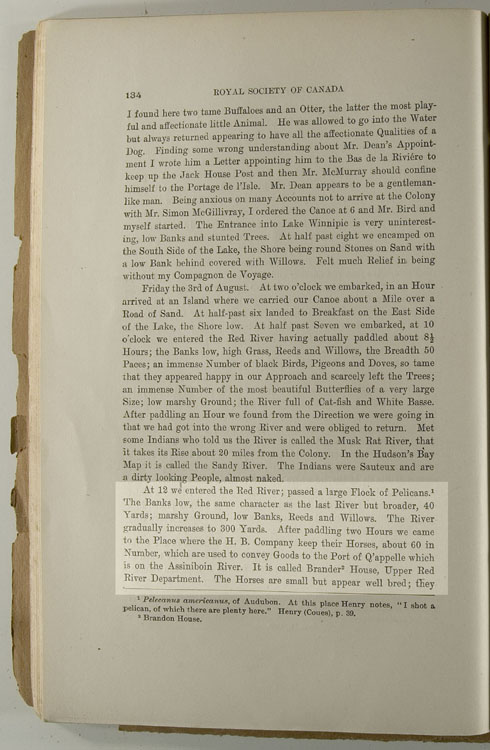
|
|
| Author: |
Nicholas Garry |
| Title: |
The Diary of Nicholas Garry |
| Publisher: |
The Royal Society of Canada |
| Year Published: |
1900 |
| Copyright Holder: |
Expired; no restrictions on use. |
|
|
|
Nicholas Garry (ca. 1782-1856) joined the HBC's board of directors in 1817. In 1821, he visited trading posts in Manitoba and northern Ontario as the Company's representative, explaining to traders and Native peoples the recently-agreed merger with the Northwest Company. He was later Deputy Governor of the HBC from 1822-1835.
This entry describes entering the Red River, August 3, 1821, found on pages 134-35 ["At 12 We entered... of the Chipeway Tribe."]
"At 12 we entered the Red River; passed a large Flock of Pelicans. The Banks low, the same character as the last River but broader, 40 Yards; marshy Ground, low Banks, Reeds and Willows. The River gradually increases to 300 Yards. After paddling two Hours we came to the Place where the H. B. Company keep their Horses, about 60 in Number, which are used to convey Goods to the Port of Q' appelle which is on the Assiniboin River. It is called Brander House, Upper Red River Department.
The Horses are small but appear well bred; they are of the Spanish Breed. Their Sufferings from the Musquitoes and Sand Flies are dreadful. They were under Tents made of the Skins of Buffaloes with Fires before them to smoke off the Flies. At the Back of the Tents are immense Plains with the most luxuriant Grass uncultivated, but furnishing ample Food for the Horses.
In ten Minutes Paddling we arrived at the Encampment of the Indians who have cultivated Fields of Corn Indian. Their Chief is called the Cut Nose from having lost a Part of his Nose in an Affray. He is a good looking Man of 50, has always been a great Friend of the Colony and once actually defended it from the Attacks of their blood thirsty Enemies.
Having no Rum I promised to make him a formal Visit on my Return. There were a great many Women; the Chief's Daughter very pretty. The Cut Nose is anxious that Mr. Bird's Son should marry her. The young Men were gone on a War Party to attack their Enemies the Sieux. These Indians are Sauteux, so called by the French; they are of the Chipeway Tribe."
Other
Related Material
Read more excerpts from Nicholas' diary - enter 'Garry' in the search box to your left.
The 'Cut-Nosed' Chief is found in other writings - enter 'Peguis' in the search box to your left.
What does Nicholas Garry look like?
Check the Beaver Index - Highlights of the First 200 Years of the Hudson's Bay Company, Glyndwr Williams, Autumn 1970; From Diary of Nicholas Garry, March 1931; John West, Peguis and P. Rindisbacher, by Harry Shave, Summer 1957.
Read more about Chief Peguis in the Dictionary of Canadian Biography Online.
|
Did
You Know?
Nicholas Garry was the first member of the HBC's London Committee to visit the Company's territories in North America.
He volunteered for the assignment, and was accepted partly because of his past experience with northern travelling (as a young man, he had traded in Russia and along the coast of the Baltic Sea) and partly because he was the only bachelor on the Committee.
|
|